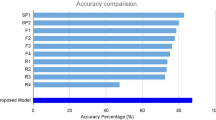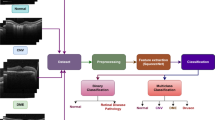Abstract
Since introducing optical coherence tomography (OCT) technology for 2D eye imaging, it has become one of the most important and widely used imaging modalities for the noninvasive assessment of retinal eye diseases. Age-related macular degeneration (AMD) and diabetic macular edema eye disease are the leading causes of blindness being diagnosed using OCT. Recently, by developing machine learning and deep learning techniques, the classification of eye retina diseases using OCT images has become quite a challenge. In this paper, a novel automated convolutional neural network (CNN) architecture for a multiclass classification system based on spectral-domain optical coherence tomography (SD-OCT) has been proposed. The system used to classify five types of retinal diseases (age-related macular degeneration (AMD), choroidal neovascularization (CNV), diabetic macular edema (DME), and drusen) in addition to normal cases. The proposed CNN architecture with a softmax classifier overall correctly identified 100% of cases with AMD, 98.86% of cases with CNV, 99.17% cases with DME, 98.97% cases with drusen, and 99.15% cases of normal with an overall accuracy of 95.30%. This architecture is a potentially impactful tool for the diagnosis of retinal diseases using SD-OCT images.














Similar content being viewed by others
References
Kermany DS, Goldbaum M, Cai W, Valentim CCS, Liang H, Baxter SL, McKeown A, Yang G, Wu X, Yan F, Dong J, Prasadha MK, Pei J, Ting MYL, Zhu J, Li C, Hewett S, Dong J, Ziyar I, Shi A, Zhang R, Zheng L, Hou R, Shi W, Fu X, Duan Y, Huu VAN, Wen C, Zhang ED, Zhang CL, Li O, Wang X, Singer MA, Sun X, Xu J, Tafreshi A, Lewis MA, Xia H, Zhang K (2018) Identifying medical diagnoses and treatable diseases by image-based deep learning. Cell 172(5):1122–1131 e9
Farsiu S, Chiu SJ, O'Connell RV, Folgar FA, Yuan E, Izatt JA, Toth CA, Age-Related Eye Disease Study 2 Ancillary Spectral Domain Optical Coherence Tomography Study Group (2014) Quantitative classification of eyes with and without intermediate age-related macular degeneration using optical coherence tomography. Ophthalmology 121(1):162–172
Kanagasingam Y, Bhuiyan A, Abramoff MD, Smith RT, Goldschmidt L, Wong TY (2014) Progress on retinal image analysis for age related macular degeneration. Prog Retin Eye Res 38:20–42
Lemaitre G et al (2016) Classification of SD-OCT volumes using local binary patterns: experimental validation for DME detection. J Ophthalmol 2016:3298606
Reis AS et al (2012) Influence of clinically invisible, but optical coherence tomography detected, optic disc margin anatomy on neuroretinal rim evaluation. Invest Ophthalmol Vis Sci 53(4):1852–1860
Schmidt-Erfurth U, Sadeghipour A, Gerendas BS, Waldstein SM, Bogunovic H (2018) Artificial intelligence in retina. Prog Retin Eye Res 67:1–29
Esteva A et al (2019) A guide to deep learning in healthcare. Nat Med 25(1):24–29
Ting DSW et al (2019) Artificial intelligence and deep learning in ophthalmology. Br J Ophthalmol 103(2):167–175
Ting DSW, Wu WC, Toth C (2018) Deep learning for retinopathy of prematurity screening. Br J Ophthalmol
Sajda P (2006) Machine learning for detection and diagnosis of disease. Annu Rev Biomed Eng 8:537–565
Pierro L, Zampedri E, Milani P, Gagliardi M, Isola V, Pece A (2012) Spectral domain OCT versus time domain OCT in the evaluation of macular features related to wet age-related macular degeneration. Clin Ophthalmol 6:219–223
LeCun Y, Bengio Y, Hinton G (2015) Deep learning. Nature 521(7553):436–444
Alsaih K, Lemaitre G, Rastgoo M, Massich J, Sidibe D, Meriaudeau F (2017) Machine learning techniques for diabetic macular edema (DME) classification on SD-OCT images. Biomed Eng Online 16(1):68
Awais M, Müller H, Tang TB, Meriaudeau F (2017) Classification of sd-oct images using a deep learning approach. In: 2017 IEEE International Conference on Signal and Image Processing Applications (ICSIPA), IEEE, pp 489–492
Lee CS, Baughman DM, Lee AY (2017) Deep learning is effective for the classification of OCT images of normal versus age-related macular degeneration. Ophthalmol Retina 1(4):322–327
Karri SP, Chakraborty D, Chatterjee J (2017) Transfer learning based classification of optical coherence tomography images with diabetic macular edema and dry age-related macular degeneration. Biomed Opt Express 8(2):579–592
Rong Y, Xiang D, Zhu W, Yu K, Shi F, Fan Z, Chen X (2019) Surrogate-assisted retinal OCT image classification based on convolutional neural networks. IEEE J Biomed Health Inform 23(1):253–263
Fang L, Jin Y, Huang L, Guo S, Zhao G, Chen X (2019) Iterative fusion convolutional neural networks for classification of optical coherence tomography images. J Vis Commun Image Represent 59:327–333
Rasti R, Rabbani H, Mehridehnavi A, Hajizadeh F (2018) Macular OCT classification using a multi-scale convolutional neural network ensemble. IEEE Trans Med Imaging 37(4):1024–1034
Amil P et al (2019) Unsupervised feature extraction of anterior chamber OCT images for ordering and classification. Sci Rep 9(1):1157
Srinivasan PP et al (2014) Fully automated detection of diabetic macular edema and dry age-related macular degeneration from optical coherence tomography images. Biomed Opt Express 5(10):3568–3577
Mehta P, Lee AY, Lee C, Balazinska M, Rokem A (2018) Multilabel multiclass classification of OCT images augmented with age, gender and visual acuity data. bioRxiv:316349
Hussain MA et al (2018) Classification of healthy and diseased retina using SD-OCT imaging and random forest algorithm. PLoS One 13(6):e0198281
Ji Q, He W, Huang J, Sun Y (2018) Efficient deep learning-based automated pathology identification in retinal optical coherence tomography images. Algorithms 11(6)
Perdomo O, Otálora S, González FA, Meriaudeau F, Müller H (2018) Oct-net: a convolutional network for automatic classification of normal and diabetic macular edema using SD-OCT volumes. In: 2018 IEEE 15th International Symposium on Biomedical Imaging (ISBI 2018), IEEE, pp 1423-1426
Hwang DK, Hsu CC, Chang KJ, Chao D, Sun CH, Jheng YC, Yarmishyn AA, Wu JC, Tsai CY, Wang ML, Peng CH, Chien KH, Kao CL, Lin TC, Woung LC, Chen SJ, Chiou SH (2019) Artificial intelligence-based decision-making for age-related macular degeneration. Theranostics 9(1):232–245
Nugroho KA (2018) A comparison of handcrafted and deep neural network feature extraction for classifying optical coherence tomography (OCT) images. In: 2018 2nd International Conference on Informatics and Computational Sciences (ICICoS), IEEE, pp 1-6
Gnanadurai D, Sadasivam V (2005) Image de-noising using double density wavelet transform based adaptive thresholding technique. International Journal of Wavelets, Multiresolution and Information Processing 03(01):141–152
Kingma DP, Ba J (2014) Adam: a method for stochastic optimization, arXiv preprint arXiv:1412.6980
Hinton GE, Osindero S, Teh YW (2006) A fast learning algorithm for deep belief nets. Neural Comput 18(7):1527–1554
Gao F, Yue Z, Wang J, Sun J, Yang E, Zhou H (2017) A novel active semisupervised convolutional neural network algorithm for SAR image recognition. Comput Intell Neurosci 2017:3105053
Bakator M, Radosav D (2018) Deep learning and medical diagnosis: a review of literature. Multimod Techn and Interact 2(3)
Gu J et al (2018) Recent advances in convolutional neural networks. Pattern Recog 77:354–377
Alqudah AM, Alquraan H, Abu-Qasmieh I, Al-Badarneh A (2018) Employing image processing techniques and artificial intelligence for automated eye diagnosis using digital eye fundus images. JBBBE 39:40–56
Acknowledgments
The author would like to thank the Nvidia Learning Center at Yarmouk University (YU), represented by Dr. Ahmad Alomari, for providing access to the GPU Unit for training and testing the CNN architecture on the whole image dataset and getting the results. Also, the author would like to thank Zain Innovation Campus (ZINC) at Yarmouk University (YU) represented by Eng. Nour Al-Ajlouni, for providing access to the GPU Unit for initial results and testing of the CNN architecture on part of the dataset.
Availability of data and materials
The image dataset that used to test and support the findings of this research is available from different hospitals in Jordan, but restrictions apply to the availability of these data, which were used under license for the current research only, and so are not publicly available. Data are however may be available from the author upon reasonable request and with permission of all hospitals.
Author information
Authors and Affiliations
Corresponding author
Ethics declarations
Conflict of interest
The author declares that he has no conflict of interest.
Human and animal rights
This article does not contain any studies with human participants or animals performed by the author.
Informed consent
Informed consent was obtained from all individual participants included in the study.
Additional information
Publisher’s note
Springer Nature remains neutral with regard to jurisdictional claims in published maps and institutional affiliations.
Rights and permissions
About this article
Cite this article
Alqudah, A.M. AOCT-NET: a convolutional network automated classification of multiclass retinal diseases using spectral-domain optical coherence tomography images. Med Biol Eng Comput 58, 41–53 (2020). https://doi.org/10.1007/s11517-019-02066-y
Received:
Accepted:
Published:
Issue Date:
DOI: https://doi.org/10.1007/s11517-019-02066-y




